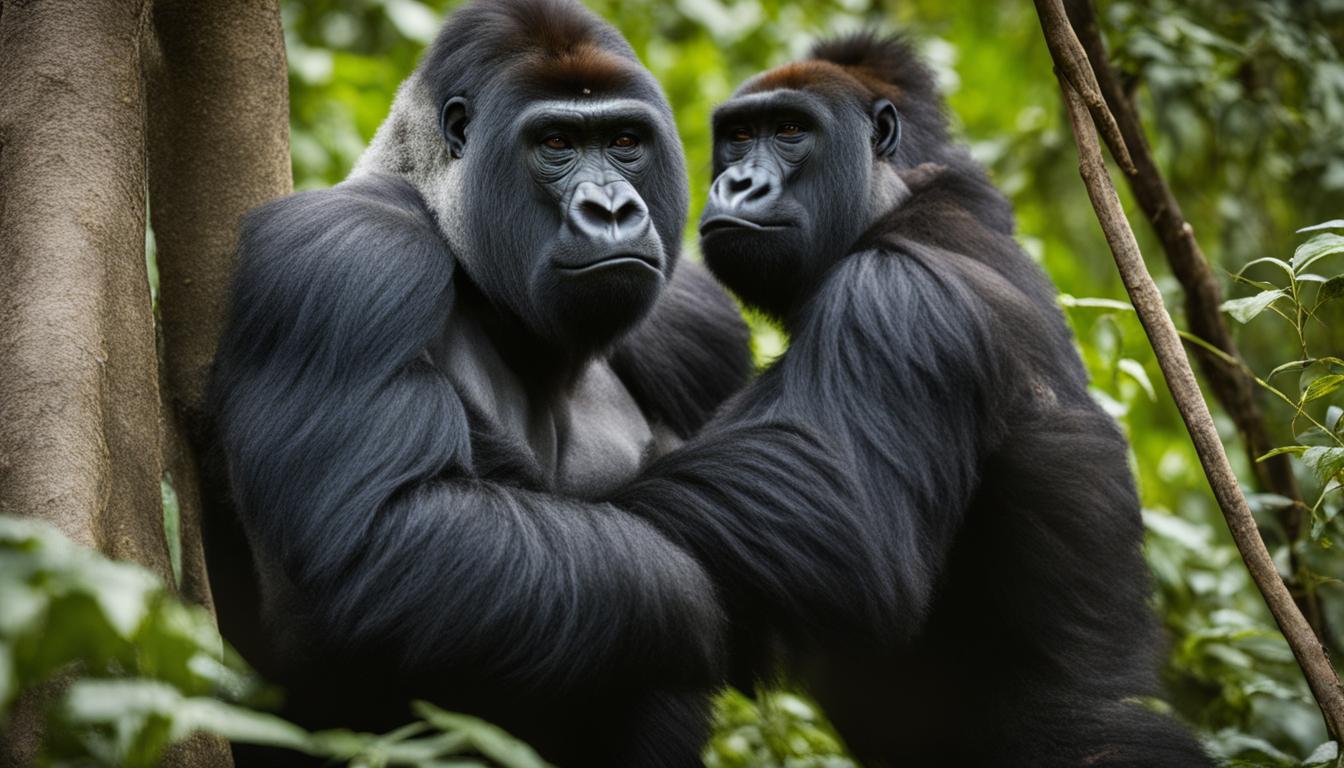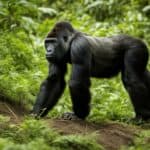Gorillas, the giant wild apes of central Africa, have developed various adaptations to thrive in their environments. With roughly 700 mountain gorillas remaining in the world, they have adapted to live in the forests of the Virunga Mountains, Uganda, Rwanda, and the Democratic Republic of Congo. These adaptations include physical features such as longer and thicker fur to withstand the colder rain in tropical rainforests. Gorillas live in social groups led by a dominant silverback, exhibiting behavior adaptations like body language and vocalization. They rely on vegetation for food, using their fingers to break shells off fruits. Gorillas also have the ability to detect threats and move quietly to avoid detection.
Throughout this article, we will explore the environmental, behavioral, feeding, and locomotion adaptations of gorillas. These adaptations play a crucial role in their survival and highlight their resilience in the face of evolving environments. By understanding gorilla adaptations, we gain insight into the intricate relationship between animals and their habitats.
Join us as we delve into the fascinating world of gorilla adaptations and discover the incredible ways these magnificent creatures have evolved to thrive in their unique environments.
The Environmental Adaptations of Gorillas
Gorillas have specifically adapted to their environments by living in colder rainforest regions. Their thick and long fur helps protect them from the cold, as well as from diseases and insect bites. The dense vegetation of the rainforest provides abundant food sources, eliminating the need for gorillas to migrate long distances in search of food. These environmental adaptations have allowed gorillas to thrive in their habitats and ensure their survival.
One of the key environmental adaptations of gorillas is their thick and long fur, which serves as insulation against the cold and helps them regulate their body temperature. This adaptation is crucial for gorillas living in colder rainforest regions where temperatures can drop significantly. The fur not only keeps them warm but also provides protection against moisture, diseases, and insect bites.
Furthermore, the dense vegetation of the rainforest provides a rich food source for gorillas. Their habitat is abundant with leaves, shoots, fruits, and other vegetation, which eliminates the need for gorillas to travel long distances in search of food. This adaptation allows gorillas to conserve energy and spend more time in their preferred habitat. By staying in a localized area with abundant food, gorillas can establish and maintain stable social structures and ensure their survival.
| Environmental Adaptations | Description |
|---|---|
| Thick and long fur | Provides insulation against the cold and protection against diseases and insect bites. |
| Dense rainforest vegetation | Provides abundant food sources, eliminating the need for long-distance migrations in search of food. |
Gorilla Environmental Adaptations: Quotes
“The thick fur of gorillas not only keeps them warm in colder rainforest regions but also provides protection against moisture, diseases, and insect bites.” – Gorilla Conservation Expert
“The dense vegetation of the rainforest ensures a stable food source for gorillas, allowing them to establish and maintain their social structures in one area.” – Primatologist
In conclusion, the environmental adaptations of gorillas, such as their thick fur and the abundance of food sources in their rainforest habitats, have played a crucial role in their survival. These adaptations enable gorillas to withstand the cold, stay protected from diseases and insects, and maintain stable social structures. By understanding and appreciating these adaptations, we gain a deeper insight into the remarkable resilience of gorillas and the intricate relationship between animals and their habitats.
The Behavioral Adaptations of Gorillas
Gorillas have developed a range of behavioral adaptations that contribute to their survival in their natural habitats. One of the key aspects of their behavior is living in social groups or families led by a dominant silverback. This social structure provides a sense of security and ensures the well-being and growth of the group. Each gorilla within the group has a specific role, and the dominant silverback dictates daily activities such as feeding and sleeping.
“Living in social groups allows gorillas to rely on each other for support and protection.”
Communication is an essential part of gorilla behavior, and they employ various methods to convey emotions, needs, and desires to other group members. This includes body language, vocalization, and expressive faces. Through these forms of communication, gorillas can establish social hierarchies, resolve conflicts, and maintain harmonious relationships within the group.
Gorillas also exhibit secretive behavior as a defense mechanism. They have the ability to detect potential threats in their environment and quietly move to avoid detection. This behavior minimizes conflicts and helps to maintain the safety and security of the group as a whole.
Gorilla Social Adaptations
The social adaptations of gorillas are crucial to their survival and well-being. Living in social groups allows gorillas to rely on each other for support and protection. They form strong bonds within their groups, fostering a sense of community and cooperation. This social structure ensures that the group works together to find food, care for the young, and defend against potential threats.
Overall, the behavioral adaptations of gorillas highlight their intelligence and ability to adapt to their surroundings. By living in social groups and employing various communication methods, gorillas are able to thrive in their environments and ensure their survival as a species.
| Behavioral Adaptations | Description |
|---|---|
| Living in social groups | Gorillas live in groups led by a dominant silverback, ensuring the well-being and growth of the group. |
| Communication | Gorillas use body language, vocalization, and expressive faces to convey emotions, needs, and desires to other group members. |
| Secrecy | Gorillas exhibit secretive behavior, detecting and avoiding threats to maintain the safety and security of the group. |
| Social Adaptations | Gorillas form strong bonds within their groups, fostering a sense of community and cooperation for support and protection. |
The Feeding Adaptations of Gorillas
Gorillas have developed remarkable adaptations when it comes to their feeding habits. As herbivores, they rely on vegetation as their primary food source. Their diet consists of plants and fruits found in their habitats, which provide the necessary nutrients for their survival.
One of the key feeding adaptations of gorillas is their ability to break shells off fruits using their fingers. This precise dexterity allows them to access the nutritious contents inside, ensuring they can obtain the essential vitamins and minerals needed for their well-being. Additionally, gorillas possess flat teeth that are specifically designed for chewing and grinding cellulose, the main component of plant cell walls. This adaptation enables them to efficiently process and digest the fibrous vegetation they consume.
A fascinating aspect of gorilla feeding adaptations lies in their colons. Bacteria present in their colons play a crucial role in breaking down the indigestible plant cellulose, converting it into valuable digestible carbohydrates through the process of fermentation. This unique adaptation allows gorillas to extract as much energy as possible from the plant-based diet, ensuring their nutritional needs are met.
| Feeding Adaptations | Benefits |
|---|---|
| Precision in breaking fruit shells using fingers | Accessing nutritious contents |
| Flat teeth designed for chewing and grinding cellulose | Efficiently processing fibrous plant material |
| Bacteria in the colon aiding in fermentation | Converting indigestible cellulose into digestible carbohydrates |
The feeding adaptations of gorillas are essential for their survival and overall well-being. By understanding these remarkable adaptations, we gain a deeper appreciation for the unique ways in which gorillas have evolved to thrive in their environments.
“Adaptation is key to the survival of any species, and gorillas exemplify this through their incredible feeding adaptations. Their ability to break fruit shells, process fibrous vegetation, and utilize bacterial fermentation highlights the efficiency and resourcefulness of these majestic creatures.” – Wildlife Biologist
The Locomotion Adaptations of Gorillas
Gorillas have developed remarkable locomotion adaptations that allow them to navigate their environments with ease. These adaptations are crucial for their survival and enable them to efficiently forage for food and move across their habitats.
Gorilla Arm Locomotion
Gorillas predominantly rely on their arms for locomotion. Their muscular arms, equipped with long and powerful muscles, assist them in traversing their environments. This adaptation is especially useful for climbing trees and gathering foliage, as well as for supporting their weight while moving across the forest floor. The strength and flexibility of their arms enable gorillas to move swiftly and effortlessly, showcasing their incredible adaptation to their surroundings.
Quadrupedal Walking and Knuckle-Walking
Gorillas exhibit two main forms of locomotion: quadrupedal walking and knuckle-walking. Quadrupedal walking involves gorillas using both their arms and legs to move, walking on all fours. This form of locomotion is typically observed when gorillas are moving at a slower pace or in dense vegetation. Knuckle-walking, on the other hand, is a unique adaptation seen in gorillas where they walk on their knuckles, with their wrists being flexed. This form of locomotion is commonly observed when gorillas are moving at a faster pace or on the ground.
The Benefits of Arm Locomotion
Gorillas’ arm locomotion adaptations provide them with several advantages. Firstly, their arm strength allows them to gather a variety of vegetation for their diet, ensuring they have access to a diverse range of nutrients. Their ability to climb trees also provides them with an advantage when foraging for fruits and leaves that may not be easily accessible to other animals. Additionally, their arm locomotion enables them to efficiently move through their habitats, making it easier to find food, water, and suitable sleeping sites.
Overall, the locomotion adaptations of gorillas highlight their incredible physical capabilities and their ability to thrive in their unique environments. These adaptations have allowed gorillas to successfully adapt to their surroundings and ensure their survival as one of the largest and most powerful primates in the world.
| Locomotion Adaptations of Gorillas | Benefits |
|---|---|
| Gorilla Arm Locomotion | Allows for efficient foraging and movement |
| Quadrupedal Walking and Knuckle-Walking | Enables versatile movement in different terrains |
| The Benefits of Arm Locomotion | Access to diverse food sources and efficient navigation |

Conclusion
Gorillas’ ability to adapt to their environments through physical, behavioral, and feeding adaptations is crucial for their survival. These adaptations have allowed them to thrive in the rainforests of central Africa, ensuring the continuation of their species.
Gorillas have developed various physical adaptations to withstand the challenges of their habitats. Their longer and thicker fur protects them from the cold and other environmental factors. Additionally, their behavioral adaptations, such as living in social groups led by a dominant silverback and using body language and vocalization to communicate, contribute to their survival.
Feeding adaptations, including their herbivorous diet and specialized teeth for grinding cellulose, allow gorillas to sustain their nutritional needs in their habitats. Their ability to efficiently navigate their environments using their strong arms aids in efficient foraging and movement.
Overall, gorillas’ evolutionary adaptations have allowed them to not only survive but also thrive in their unique habitats. By understanding and appreciating these adaptations, we gain a deeper insight into the resilience of these incredible creatures and the importance of maintaining the delicate balance between animals and their environments.
How Do Gorillas’ Adaptations Help Them Deal with the Effects of Climate Change in Their Habitats?
Gorillas’ adaptations play a crucial role in helping them cope with the impacts of climate change in their habitats. Their ability to forage for diverse plant species and adjust their feeding habits allows them to thrive in changing landscapes. Additionally, their social structure enables them to share knowledge and resources, making them resilient in the face of gorillas and climate change.
FAQ
How have gorillas adapted to their environments?
Gorillas have developed various adaptations to thrive in their environments, including physical features, behavioral traits, feeding strategies, and locomotion adaptations.
What are the environmental adaptations of gorillas?
Gorillas have adapted to live in the forests of the Virunga Mountains, Uganda, Rwanda, and the Democratic Republic of Congo. They have longer and thicker fur to withstand the colder rain in tropical rainforests, allowing them to survive in their cold habitat.
What are the behavioral adaptations of gorillas?
Gorillas live in social groups led by a dominant silverback, exhibiting behavior adaptations like body language and vocalization. They rely on these communication methods to convey emotions, needs, and desires to other group members, ensuring the well-being and growth of the group.
How do gorillas adapt their feeding habits?
Gorillas are herbivores and adapt to their environment by consuming vegetation as their main food source. They feed on plants and fruits found in their habitats, utilizing their fingers to break shells off fruits. Their flat teeth and bacteria in their colons aid in breaking down the indigestible plant cellulose, converting it into valuable digestible carbohydrates through the fermentation process.
What are the locomotion adaptations of gorillas?
Gorillas predominantly use their arms for locomotion, relying on their large arm muscles to gather foliage and facilitate their movements. This adaptation allows them to efficiently forage for food and traverse their habitats, whether it be climbing trees or moving across the forest floor.







